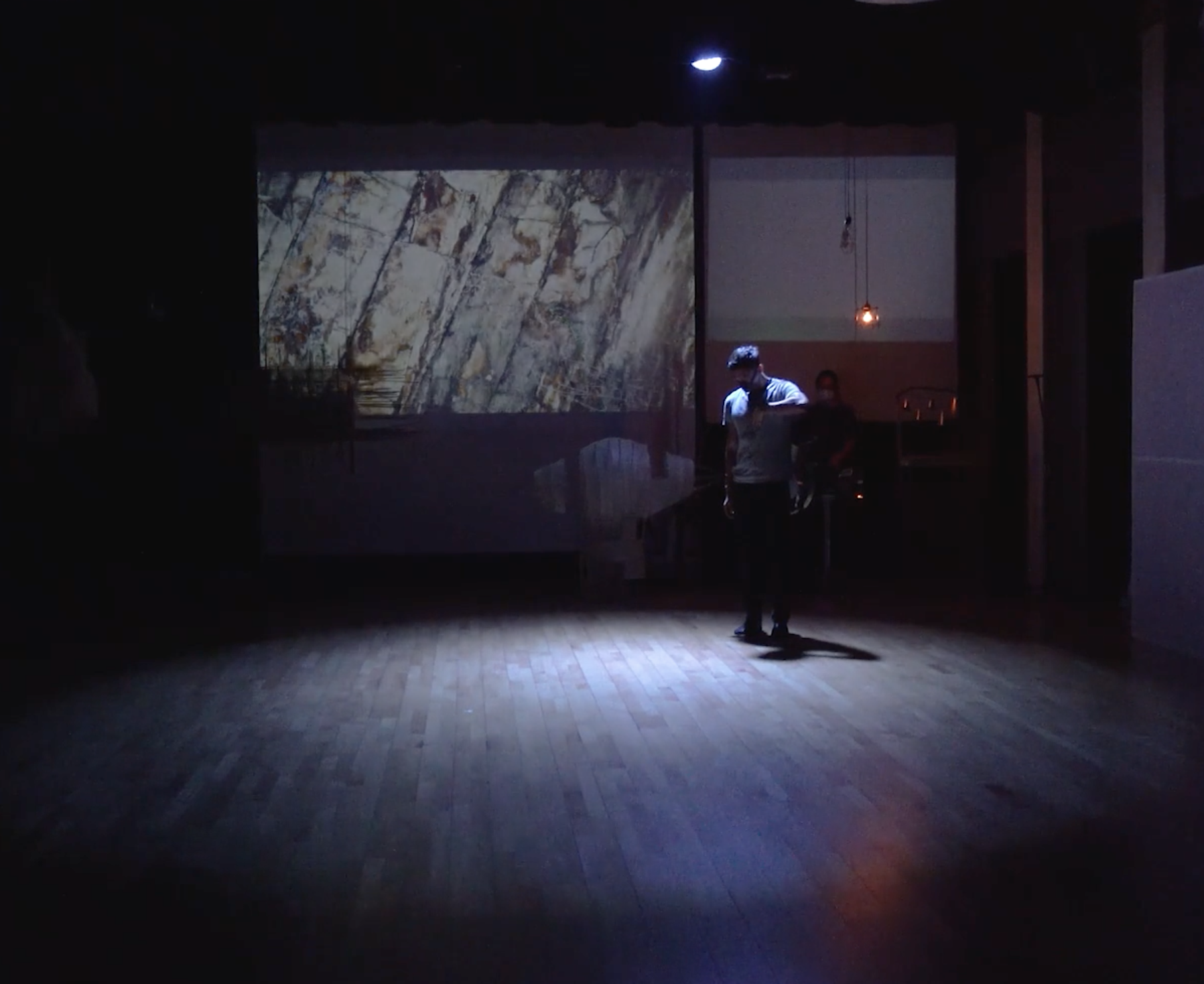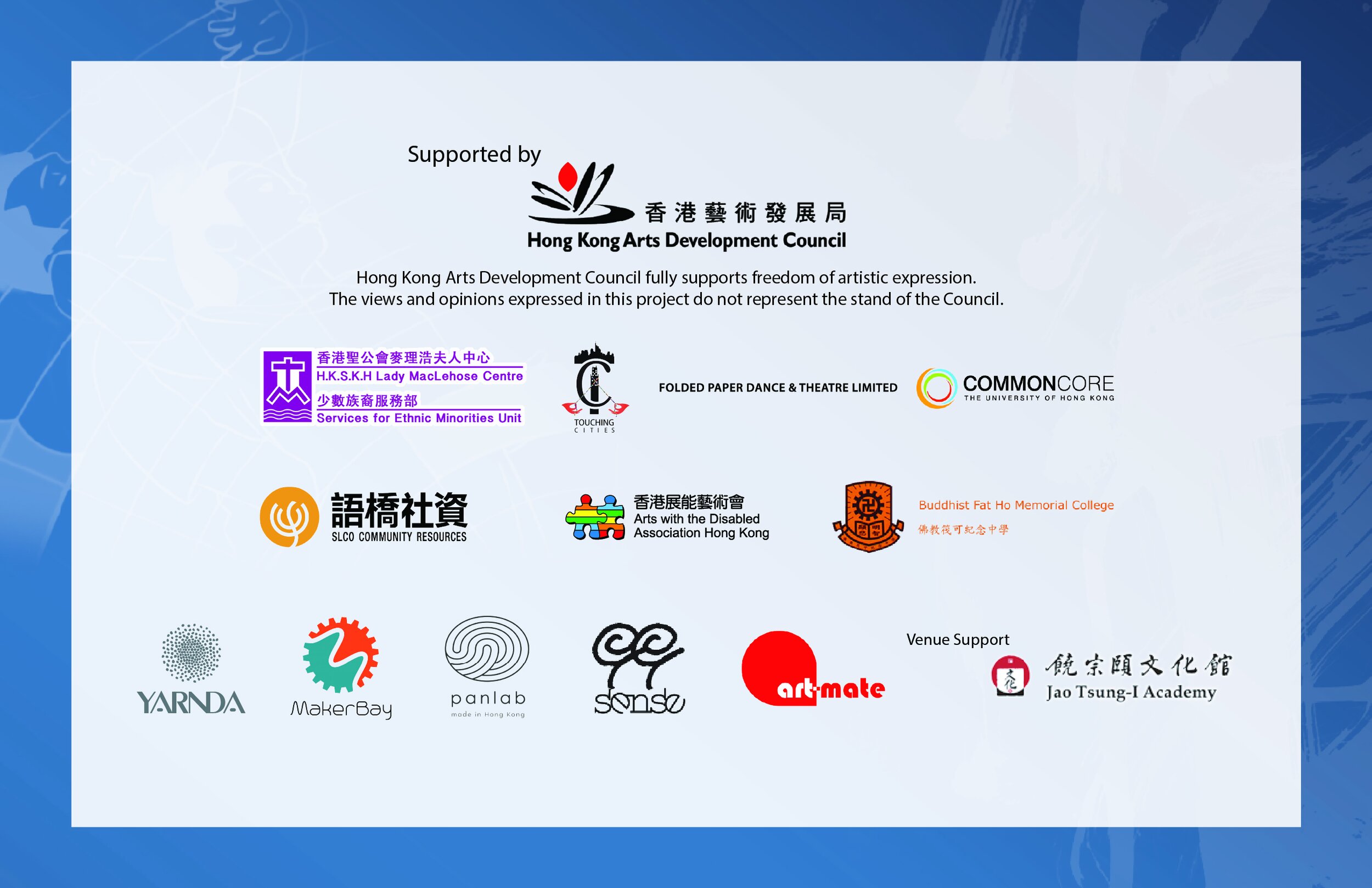Article Two:
Sounding Bodies Intermedia in Hong Kong: Intermedia Dance and Disability Aesthetics
Article One: An Overview of the Sounding Bodies Intermedia in Hong Kong Project (Link)
Article Three: Sounding Bodies Intermedia in Hong Kong: Engaging Diverse Audiences (Link)
Intermedia Dance and Disability Aesthetics:
Intermedia Dance Arts as More Than
Kanta Kochhar, Ph.D. with Contributions from Sounding Bodies Collective Members
Sounding Bodies: Intermedia in Hong Kong [1] engaged in multiple forms of arts, archival, and ethnographic research so that we could develop a variety of entry points into an arts practice and making process needed for this project. We wanted to open new possibilities for the “more than” of the multisensory—that is more than one approach, more than one art form, more than each individual artist contribution, more than one cultural community contribution, and more than simply the sum of the pieces of sensory, perceptual, experiential, linguistic, and cultural reference points. This process led to a sort of artistic vertigo which required that we find other ways to listen and sense our way through these emergent spaces toward something else.
The project evolved through several collaborative phases: Research and Development; Innovation Workshops and accompanying workshops on Artistic Research: Diving In and on the Apprentice’s Mind; A Lecture-Demo; Crossing the Senses Exhibit, Demo, and Talks; and the Sounding Bodies; Light, Image, and Empty Spaces Interactive Sessions and Dance Performances at the Jao Tsung-I Academy (May 7-9, 2021). Navigating these various activities with different artistic leads and participants has resulted in very rich cross-fertilization process for sharing, testing, and refining our ideas and outcomes. Central to this process was the guiding question of: What is the smallest compositional unit that we can make and still be able to call it a performance?
[1] Sounding Bodies is supported by the Hong Kong Arts Development Council. Cooperating organizations include HKU’s Common Core+; JTIA (with Venue Support); SLCO-CR; Accessibility Partner: Arts with the Disabled Association Hong Kong; HKSKH Lady MacLehose Centre Services for Ethnic Minorities; Yarnda; Buddhist Fat Ho Memorial College; MakerBay; Sense 99; and Panlab as well as generous friends of Folded Paper.
The research on Intermedia acknowledges that there is a history to innovation in bringing art forms together to create something new, and it gestures toward many of the “in-between” spaces of art forms. Sounding Bodies moves between dance and architecture; between sound instruments and sculptures; between the moving images of the dancers, the projections, and the set pieces. Aiming to be accessible through cross-sensory compositions as touch-sight-sound experiences, the event itself draws the performers and audience alike into the present as each new sense experience meets the next one. Lily Diaz and Ken Friedman note that “[i]ntermedia works cross the boundaries of recognized media, often fusing the boundaries of art with media that have not previously been considered art forms.” [1]
We experimented with many things such as architectural costumes, sound sculptures and instruments, spatial blends of image and light, projection and live feed, multiple spatial compositions in an always changing installation space.
[1] Lily Diaz and Ken Friedman. (2018). “Intermedia, Multimedia, and Media” in Adaptation and Convergence of Media. Aalto: Aalto University Press. (Link: https://monoskop.org/images/6/66/Friedman_Ken_Diaz_Lily_2018_Intermedia_Multimedia_and_Media.pdf)
“Being creative is not so much the desire to do something as the listening to that which wants to be done: the dictation of the materials.”
Please note that all sections in the boxes showcase selected contributions from the Sounding Bodies Collective Members.
Christine He
A. On Intermedia
B. Image from a Research Clip where Christine uses the IPhone.
C. Image from the Show: where Christine uses the IPhone and the live feed is projected on the screen upstage.
D. See a video trailer from Sounding Bodies Dance Performance. Click Here. (Link: https://vimeo.com/601369013)
Chun To Yeung
Key Idea (a)
Motion depends on movers, and movers on motion. They are co-dependent descriptors.
Dance Equivalent:
Initiate a move, and then let the motion tell the mover where it wants to go. Explore this relationship.
Vocal Equivalent: Ooooo (d)
Why? (m t l)
A. Image from the Performance
B. Video Clip from Sounding Bodies Dance Performance. Click Here. (Link: https://vimeo.com/601372112)
Where? (l)
When? (r)
What? (r or d of new key)
Who am I? (r or s of new key – _s l m + riff)
Who are you? (riff)
Who are we? (riff)
What are we? (riff)
Who what when where why? (spoken)
Who what when where why? (spoken)
Who what when where why? (spoken)
Who what when where? (spoken)
Oh!
Who what when where why? (spoken)
Who what? (spoken)
—Chun To Yeung
Hong Pak Lau
“Arts are to touch people and allow people to be touched in a feedback loop where all the stakeholders are. We are acting and reacting any time anywhere.”
Prelude to Sounding Bodies Dance Performance (Sounding Bodies: Light, Image, and Empty Spaces)
A. Image of Movement interpretation of the Mustard Seed quote.
B. Video Clip from Sounding Bodies Dance Performance. Click here. (Link: https://vimeo.com/610193580)
Rhyn Cheung: Notes and Reflections on the Reading
“…more about incorporating more style of media together in one show and the goal is always to saturate different senses at once. They also are very determined to make audience as part of the project, not spectators…”
Meditation on Intermedia
“An everyday bus ride can in fact be an unintentional synesthetic experience that is not dissimilar to those carefully orchestrated by intermedia artist. First of all, sound, light, projection, audience, actions, and structures are often critical elements of an intermedia piece. If we imagine sounds within the bus environment as a factor directing this piece, there are many possibilities. For example, the stop announcement may lead to people getting off the bus, or people talking on the bus may change someone’s emotion. As the bus is continuously moving, scenes outside of the window are ever changing as well. We can imagine them as mini screens which are projections of movies from different walks of life. Audience member and actions (paying with Octopus card, pressing the stop bell, deciding where to take a seat) are all interactive motions that will lead to something other actions to follow. Finally, the bus as a structure is a moving theatre itself that invite audience members along its journey.”
A. Rhyn Moves the Sound Earth Box.
B. Video Clip from Sounding Bodies Dance Performance. Click here. (Link:https://vimeo.com/610192158)
TZ: Light Trolley as a Performer
A. Soraya with the Light Trolley
B. Video Clip from Sounding Bodies Dance Performance. Click Here. (Link: https://vimeo.com/601373820)
To Wun: Setting as Performer
A. Image at Earth Chest
B. Video Clip from Sounding Bodies Dance Performance. Click here.. (Link: https://vimeo.com/610288467)
Tif Yu: Projection as Performer
A. Image of Projections on screens with performers in front.
. B. Video Clip from Sounding Bodies Dance Performance. Click here. (Link:https://vimeo.com/610207362)









